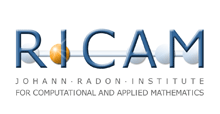Systems
Laser tomography adaptive optics (LTAO)
LTAO
In the absence of a bright star in the vicinity of the object of interest, a laser guide star (LGS) can be used. The LGS is combined with at least one natural guide star (NGS) to correct for the low order modes, which are not available using the LGS alone. In the general setting, a combination of several LGSs and NGSs is possible.
A laser tomography adaptive optics (LTAO) system is an adaptive optics system that utilizes LGSs and NGSs in combination, to provide a correction using a single deformable mirror (DM) towards a direction within the observable region of the instrument.
The correction is performed in two steps. In the first step, the refractive index fluctuations in the atmosphere are reconstructed from measurements of all wavefront sensors. This step is known as atmospheric tomography. In the second step, the DM is chosen by the shape of the wavefront projected through the reconstruction in the direction of interest.
There are crucial differences in performing atmospheric tomography, as opposed to wavefront reconstruction in SCAO. Apart from solving a more complex system with larger dimensions, the intrinsic properties of the underlying problem make it unstable, in terms of the dependence of the solution on the data, and therefore harder to handle.
→ Read more about the developed reconstruction methods:


